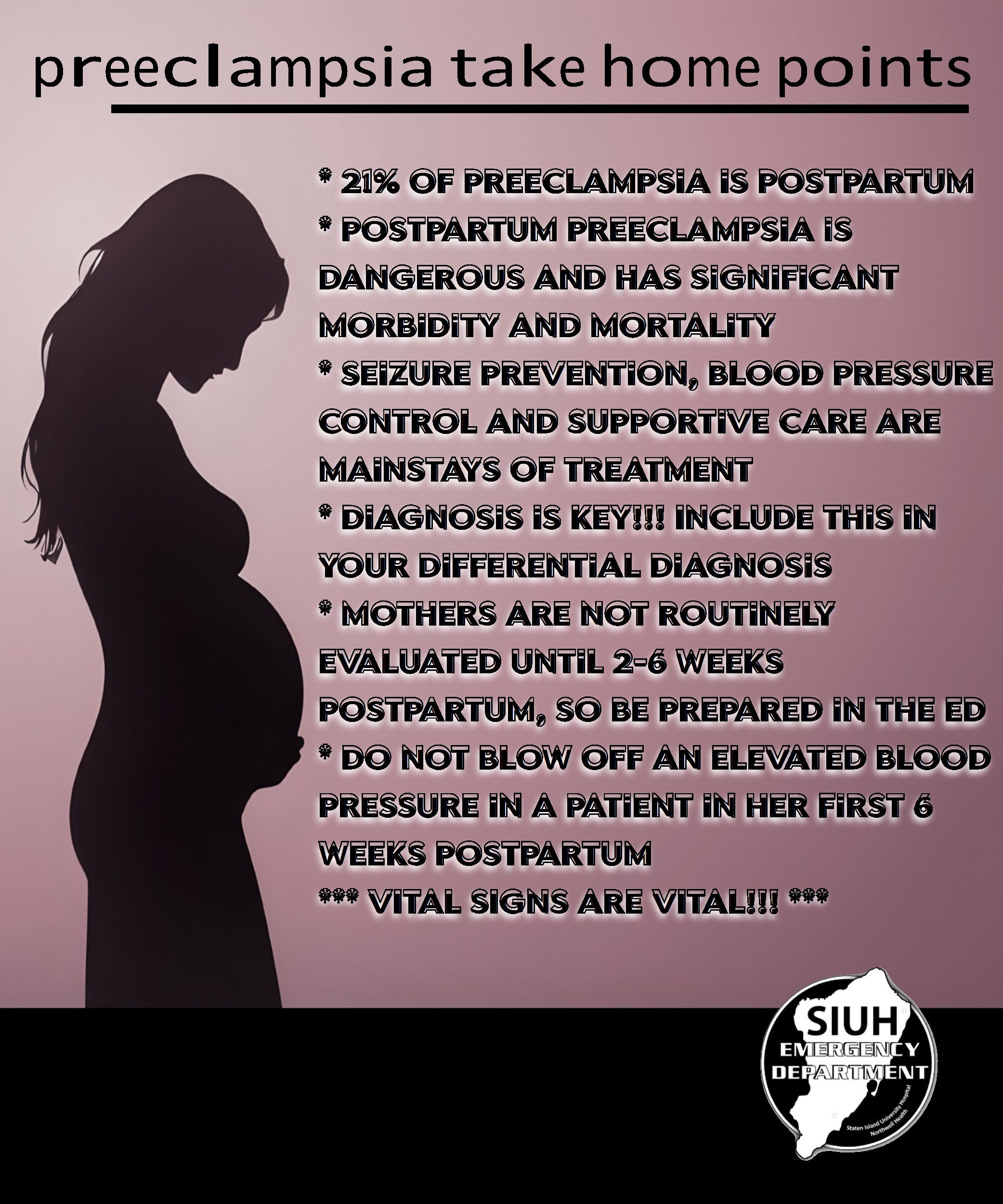Postpartum Pre-Ecclampsia Education
Charlotte Reich, MD FACEP
The Case- 38y/o female lifelong asthmatic with one remote admission, no intubation, on no maintenance therapy, BIBEMS as notification for asthma exacerbation, found tachypneic with wheeze and a room air saturation in the low 90s, given decadron 12mg, duoneb x 3, MgSO4 2 gm, refused cpap.
BTW 10 days postpartum
On arrival sitting up speaking in broken sentences, reports much improvement but tachypneic/still in some distress, HR 120s BP 169/119 RR 26 satura3on 98% on nebulizer HEENT: NC/AT, perrla, conjunctivae pink, sclerae anicteric
Neck: supple
Cor: tachycardic, regular, no murmur
Lungs: +end expiratory wheeze in upper lung fields with coarse rales and diminished breath sounds at bases L>>R
Abd: soft, nontender
Extremi3es: 1+ b/l lower extremity edema, calves nontender
Neuro: nonfocal
Is this just status asthmaticus?
Given one additional neb as she says this helped
Further history:
G4P1021 s/p NSVD at 36w5d
No prenatal care as she did not realize she was pregnant until 7 months gestation +intrapartum cocaine/alcohol/tobacco use (not disclosed)
Questionable elevated BP with prior pregnancy, 140s/90s in L&D Eloped on postpartum day 1
Had been feeling short of breath for the last few days, +orthopnea, +leg swelling, +mild headache, since resolved
No abdominal pain, chest pain, or visual disturbance; no cough, no fever, lochia resolved
Differential diagnosis:
Status asthmaticus
Postpartum cardiomyopathy
PPCM with preserved ejection fraction
Pulmonary embolism
Amniotic fluid embolism
Severe anemia
Acute renal failure
SCAD (spontaneous coronary artery dissec3on)
Postpartum preeclampsia
HELLP syndrome
Initial diagnosics:
EKG- sinus tachycardia 117 normal axis and intervals no st/t wave changes
POCUS- no pericardial effusion, no RV dila3on, grossly normal EF; B lines with pleural effusions CXR: CHF with bilateral pleural effusions L>R
Duplex: negative for DVT
Labs: WBC 19 H/H 10.9/32.3 Plt 679; Na 141 K 4.1 Cl 106 CO2 24 BUN 8 creatinine 0.7 Glucose 108 Ca 9; total protein 6.6/albumin 3.7, AP 106. T bili 0.7, AST 16/ALT 17pH 7.34 CO2 44 lactate 0.9 (venous); troponin 20, bnp 3373
uric acid 3.8 LDH 277 fibrinogen 438 ddimer 309
Clinical course:
Agreed to bipap a\er decompensa3ng when gently reclined for POCUS
Given Lasix, vital signs improved with improved respiratory mechanics and did not require aggressive BP control
Transferred North a.er discussion with OB
CTA negative for PE
Received MgSO4 4gm load and 2gm/hr for the next 24 hours, hydralazine/labetalol prn, Ativan ciwa protocol
LeftAMA after 2 days prior to official echo
Diagnosis- postpartum preeclampsia with severe features
Preeclampsia criteria:
After 20 weeks gesta:on up to 6 weeks postpartum
Blood pressure >140/90 for 2 measurements 4 hours apart OR >160/110 PLUS proteinuria (>300mg in 24 hrs or >1+ dipstick)
OR other end organ involvement (dyspnea, headache, visual changes, peripheral edema, upper abdominal/shoulder pain, nausea/vomi3ng, sudden weight gain)
Proteinuria not required to make diagnosis Other signs/symptoms may precede elevated BP
Diagnostics:
CBC (platelets <100) with smear, LFTs (AST>70, indirect bilirubin >1.2), BMP (crea3nine >1.1 or double baseline), uric acid (>5.6, highly specific), LDH (>600), PT/PTT (elevated), fibrinogen (decreased), ddimer (elevated)
EKG, CXR, abdominal ultrasound (if pain/abnormal LFTs), CTH (if seizure/headache/visual complaints/focal neuro findings), CTA chest, echocardiogram
Management:
Seizure prophylaxis-
MgSO4 4 gm load, 1-2gm/hr for 24 hours
BP control-
labetalol 20mg IVP q10 minutes (40, 80, 80, 80, max 300mg) hydralazine 5-10mg IVP q20min (max 30mg) nifedipine10mg po q15-30 min (3 doses max)
may consider sodium nitroprusside Pulmonary edema-
Diuretics, NIPPV
Take home points:
21% of preeclampsia is postpartum
Postpartum preeclampsia associated with significant morbidity and mortality
Seizure prevention, blood pressure control and suppor3ve care are mainstays of treatment Diagnosis is key!!!
If it’s not on your differential you won’t diagnose it
Mothers are not routinely evaluated until 2-6 weeks postpartum, therefore any encounter with the healthcare establishment for any reason (eg the emergency department) is an opportunity to detect and treat a potentially life threatening condi3on
Do not blow off an elevated blood pressure in a patient in her first 6 weeks postpartum VITAL SIGNS ARE VITAL!!!
References:
Hauspurg et al. Postpartum preeclampsia/eclampsia: Defining its place and management among the hypertensive disorders of pregnancy. Am J Obstet Gynecol, 2022 Feb:226(2 Suppl);S1211-1221
Deshmukh et al. Acute postpartum heart failure with preserved systolic func3on. J Am Coll Cardiol case report, 2020 Jan, 2(1) 82-85
Fehr et al. (April 8, 2024) Clinical analysis of postpartum preeclampsia a\er an uncomplicated pregnancy. Cureus 16(4):e57834



